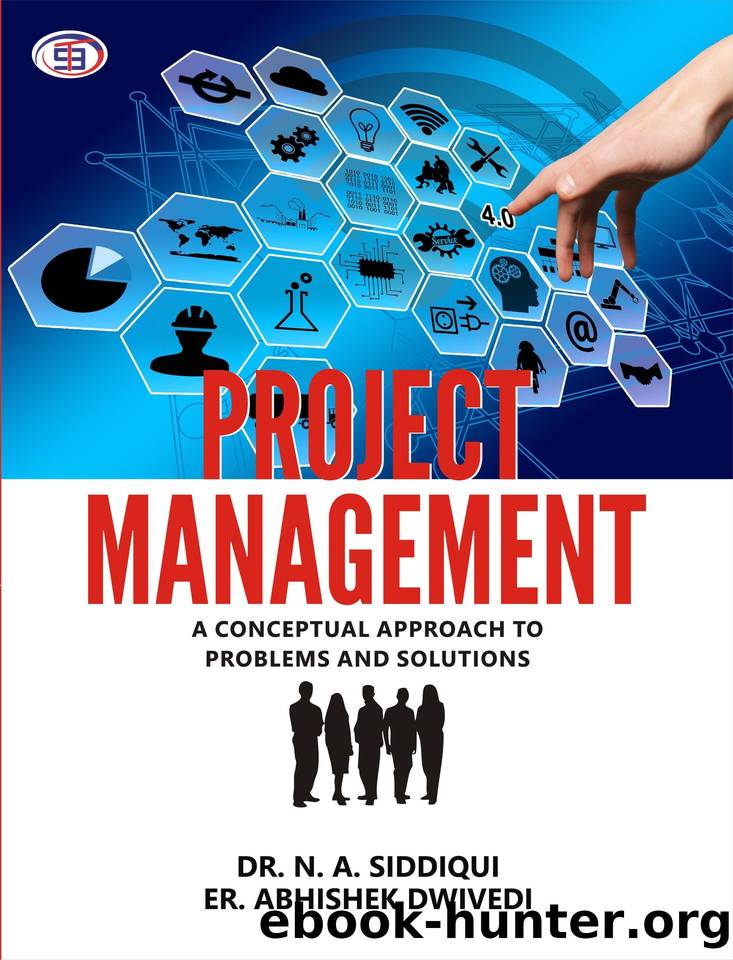Project Management : A Conceptual Approach to Problems and Solutions by Dwivedi Er. Abhishek & Siddiqui Dr. N.A

Author:Dwivedi, Er. Abhishek & Siddiqui, Dr. N.A. [Dwivedi, Er. Abhishek]
Language: eng
Format: epub
Publisher: Om SaiTech Books
Published: 2020-09-25T00:00:00+00:00
10 Project Resource Allocation and
Probabilistic Networking
Introduction, Resource Allocation, Probabilistic Network.
10.1 INTRODUCTION
Every project consists of number of activities. There may be activities which are to be performed simultaneously and may require common resources. The requirement of resources to execute these simultaneous activities may exceed the available resources. However, at some other period of the execution of the same project, there may be very few activities which may require these resources. Hence the requirement of a particular type of resource may not be uniform during the project duration.
Every management wants to allocate the limited resources to various activities in such a manner that there is best possible use of resources at disposal. PERT and CPM techniques provide valuable guidelines for most systematic and economic allocation of resources. The presence of slack or float for some of the activities enables the management to delay that activity for some time and use these resources to some more urgent activities on critical path. The resource allocation procedure consists of two main activities namely resource smoothing and resource leveling.
There are many activities in a project requiring varying level of resources. In the resource leveling process, the activities are so re-scheduled that the maximum or peak resources requirement does not exceed the limit of available resources. The available resources should, however, not be less than the maximum number of quantity required for any activity of the project. In re-scheduling, the available floats are first used. In by doing so, the resources demand is more than the available resources, the duration of some of the activities is increased so that the resources requirements for these activities is decreased. Thus in the source leveling process, the project duration, initially planned, might be increased.
10.2 RESOURCE ALLOCATION
Every project consists of number of activities. There may be activities which are to be performed simultaneously and may require common resources. The requirement of resources to execute these simultaneous activities may exceed the available resources. However, at some other period of the execution of the same project, there may be very few activities which may require these resources. Hence, the requirement of a particular type of resource may not be uniform during the project duration.
Every management wants to allocate the limited resources to various activities in such a manner that there is best possible use of resources at disposal. PERT and CPM techniques provide valuable guidelines for most systematic and economic allocation of resources. The presence of slack or float for some of the activities enables the management to delay the activities for some time and use these resources to some more urgent activities on critical path. The resource allocation procedure consists of two main activities namely Resource Levelling and Resource Smoothing.
10.2.1 Resource Levelling
Resource leveling means uniform rate of resource utilization throughout the duration of project. The utilization of resources can be leveled by shifting the starting time of a non critical activity. A non critical activity can be executed any time between its earliest start time and latest completion time if its total float is equal to its free float.
Download
This site does not store any files on its server. We only index and link to content provided by other sites. Please contact the content providers to delete copyright contents if any and email us, we'll remove relevant links or contents immediately.
Time Management Made Easy: How to Cultivate New Habits, Improve Productivity and Get Things Done by Joshua Strachan(2388)
The 7 Habits of Highly Effective People by Stephen R. Covey & Sean Covey(2196)
The Concise Laws of Human Nature by Robert Greene(1801)
Doesn't Hurt to Ask by Trey Gowdy(1602)
Primal Leadership by Daniel Goleman(1215)
Hook Point: How to Stand Out in a 3-Second World by Brendan Kane(1162)
HBR's 10 Must Reads 2021 by unknow(1071)
Don't Sweat the Small Stuff...and It's All Small Stuff by Richard Carlson(1067)
Amazon Unbound by Brad Stone(1010)
100 Things Successful People Do by Nigel Cumberland(996)
HBR's 10 Must Reads 2021 by Harvard Business Review(980)
Master of One by Jordan Raynor(969)
The Job Closer by Steve Dalton(968)
Lives of the Stoics by Ryan Holiday & Stephen Hanselman(934)
Declutter Your Mind: A step by step guide to learn to control your thoughts, stop worrying, relieve anxiety and eliminate panic attacks and negative thinking by Mia Chandler(917)
The Power of 100! by Shaun King(907)
Conflicted by Ian Leslie(833)
Coders at Work: Reflections on the craft of programming by Peter Seibel(817)
The Book of Hope by Jane Goodall(803)
